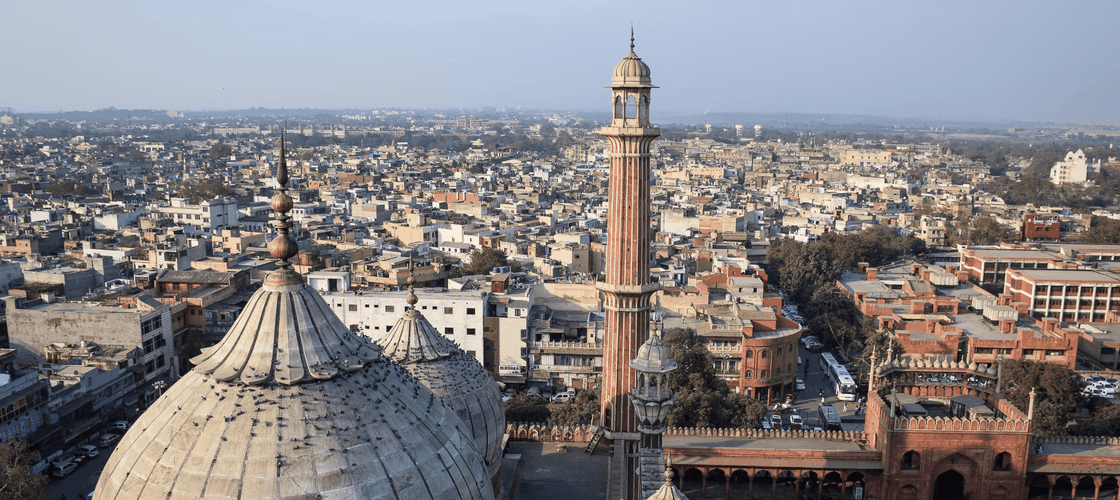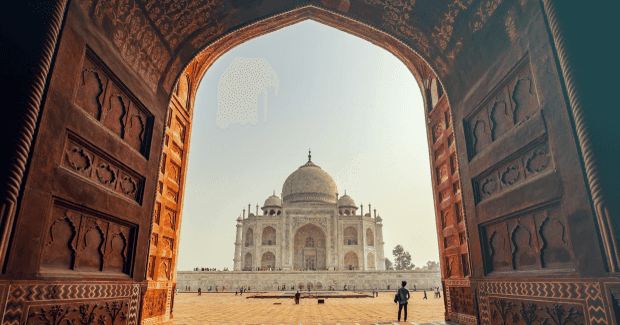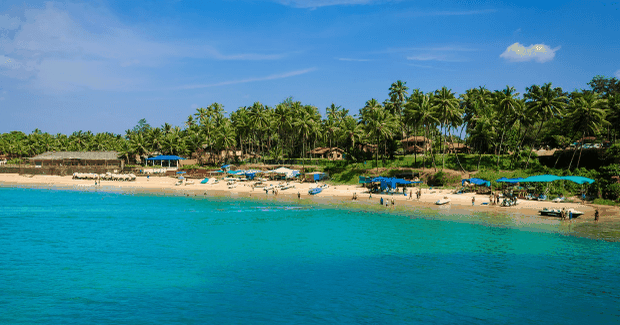Digital Nomad Visa For India

Quick Visa Facts
Visa length 1 year, 5 years, or 10 years (US and Japanese citizens only)
Possible to extend? No
Who can apply? Anyone NOT from one of the following countries (temporary restriction): Canada, China, Hong Kong, Indonesia, Iran, Kazakhstan, Kyrgyzstan, Macau, Malaysia, Qatar, Saudi Arabia, Sri Lanka, Tajikistan, United Kingdom, Uzbekistan
Minimum Income Requirements None
Time for visa applications Three business days processing time due to electronic nature
Want to know if you can apply?
Complete a visa quiz and see if you qualify!
Quick facts about India

After China, India is the second-most populous country in the world. There are over 1.3 billion people throughout the 29 states and seven territories. There are 38 UNESCO heritage sites in India, which means there is no shortage of things to see and do. Indian culture traces back thousands of years, so you will want plenty of time in the country to fully experience everything it offers.
India has long been one of the best places for digital nomads, as the cost of living is low and there is so much to do. With the addition of an e-Tourist visa that allows you to stay longer than the traditional tourist visa, you can now spend your days eating delicious food and observing incredible architecture.
Capital New Delhi
Form of Government Parliamentary constitutional republic
Population 1,352,642,280
Climate Mostly tropical
Language Hindi
Currency Indian Rupee (INR)

45 people in India!
Join the community of remoters!
Living in India as a digital nomad
India is one of the most culturally rich and geographically beautiful countries, making it a great place to see extraordinary views or breathtaking architecture. It is also one of the most spiritually rich places in the world, with a long history of Buddhism and Hinduism. India is a fantastic place to live as your money goes much further. Your overall quality of life will exceed the US for the same price.
You can find lots of other ex-pats in the content-sized country. You can also get a non-resident ordinary bank account for short-term stays up to six months. India boasts a lot of diversity; each city feels like a new country. So there is a lot to be stimulated throughout the country as each of your senses absorbs the culture.
The people are generally very welcoming to foreigners and happy to help in any way you need. The internet can be challenging outside major cities, so you might consider joining coworking spaces like 91SpringBoard for the most reliable internet.
Attractions and best places to visit

Taj Mahal
The Taj Mahal is an awe-inspiring piece of architecture in Agra. It is one of the New Seven Wonders of the World, and for a good reason. Construction began in 1632 to house the tomb of the emperor Shah Jahan’s favorite wife.
Also located on the land are a mosque and gardens. More than six million people visit the Taj Mahal every year. You can get to the mausoleum in about two to three hours from Delhi via train.
Ranakpur Jain Temple
This temple is one of the most important temples in Jain culture. Construction began in the early 15th century and took around 50 years. It is famous because of its architecture and significance. You can teach Ranakpur via Udaipur, which connects easily to the rest of the country.
Palolem Beach
Another must-see spot in India is Palolem Beach, located in the fantastic city of Goa. It is in the shape of a crescent, letting you see both ends while sitting in the center of the beach. The waters are calm, but the nightlife is anything but.
You can easily access a variety of wildlife, including birds, monkeys, and turtles. Many describe the beaches of South Goa to be more relaxing than the beaches of North Goa.
Kinnaur, Lahaul, and Spiti (Himalayans)
The Himalayan Mountains are home to some of the highest peaks on the planet, including Mount Everest. The Spiti Valley is in the Himalayas dividing India and Tibet. It is one of the least populated areas in India but is still worth a visit.
You can expect to find the most breathtaking views you have ever seen here. It is an important center for Buddhism, so visit the Key Monastery and Tabo Monastery, some of the oldest in the world.
Qutub Minar
This is the highest tower in India at 73 meters high, erected in 1193 to celebrate the fall of the last Hindu ruler in India. It is also a UNESCO heritage site and is in South Delhi.
Ramoji Film City
This film studio complex is the largest in the world and is worth a visit for the whole family. The complex is over 2000 acres and attracts millions of visitors each year.
Whatever you are interested in, India offers something to give you a whole new perspective on the things you already love.
Cost of Living
The cost of living in India is very inexpensive. Rent for a one-bedroom averages between $100-500 in India and falls cheaper on average in places like Goa or Bangalore. When looking for a place to stay, consult CitizenRemote’s guide on how to find accommodation as a digital nomad.
Food is affordable, as eating out can be done for less than $5 a meal. The food is exceptional for the price. Market prices are low and are comparable to the US.
Internet and phone bills are also very inexpensive, with monthly internet only costing around $10 per month. Even the price of first-world commodities like new cars can be found cheaper than in the US. So you can live a similar quality of life to the US or Europe for a fraction of the price.
Is India safe?
Overall, India is a very safe place to visit. Violent crime is not very common, but petty theft can happen. This is the case for any major city you visit, so exercise standard precautions when walking around.

More rural areas are less safe for foreigners, but you should have no trouble in the big cities. Make sure you follow the cultural and religious norms wherever you visit and read up on the customs and traditions, so you do not offend anyone.

Our Community Drives it all
Join the community of remoters!
Visa Overview
The Indian eVisa is an online travel authorization that simplifies obtaining a visa to visit India. The Indian electronic visa can be quickly obtained after completing an online form with the traveler’s details and passport information.

Technically speaking, this is not strictly a “digital nomad visa” but will allow you to work remotely while living in the country. It is important to note that the e-tourist visa is valid for one year or five years, but you can only stay in the country for 90 days at one time, or 180 days if you are from the United States or Japan. Once you reach that time limit, you must leave the country and then return for another 90 or 180 days.
There is no limit to how many times you can enter while your visa is valid. Therefore, you must have your return/exit ticket to present whenever you enter the country, showing that you will not overstay your allotted time.

Our Community Drives it all
Join the community of remoters!
Who Can Apply for the Digital Nomad Visa for India?
Anyone not from one of the following countries (temporary restriction)
If you are not from any of the above countries, you are welcome to apply for the e-Tourist visa. However, you can only apply for a longer 10-year visa if you are from the United States or Japan.
How to Apply for the India Digital Nomad Visa
The application process for the India Digital Nomad Visa is straightforward. First, decide whether you want a one-year or five-year multiple entry visa, and then fill out the online application. Next, pay the eVisa fee, receive the Electronic Travel Authorization by email, print it out, and present it to the Immigration Check Post.

If you have questions while filling out the application, the official website has a list of FAQs to reference.
Documents required to apply for the digital nomad visa in India
Full name as it appears on the passport
Date and place of birth
Address and contact info
Passport details
Nationality
Marital status
Profession or occupation
Details of stay: places to be visited while in India
Expected port of entry
Religion
Educational qualification
How much does the India digital nomad visa cost?
The cost will depend on where you come from, with some countries waiving the application fee while others still have to pay. The highest application fees are around $80 from places such as the USA, Russia, and Ukraine, while those from most other countries spend about $50. You can find the full spreadsheet of the country-by-country costs here. As expected, getting a single-entry 30-day visa is much cheaper than a multiple-entry 5-year visa.

Our Community Drives it all
Join the community of remoters!
Timeline for Applying for the India digital nomad visa
Luckily, the process is swift because it is all filed electronically. Application processing takes as little as three business days. Therefore, you must apply at least four days before your planned arrival, but you can submit your application as much as 120 days in advance.
This visa is an excellent option for digital nomads that do not like to plan too far in advance. Once you know you want to go to India for a few months, you can solidify your plans in less than a week.

No matter what you are looking for, India can provide it. Whether you want the tech capital in Bangalore, beaches in Goa, or starting your spiritual journey in Rishikesh, you will be able to have the experience of a lifetime. The e-tourist visa makes traveling and living in India easier than ever. The only downside is that you will have to leave the country every few months, but you can come back and start fresh.
Author
Harrison Pierce is a full-time digital nomad and freelance writer.
He specializes in travel and personal finance and works with a variety of companies and publications to create meaningful content. Harrison travels with his cat, Isabelle, and spends most of his time in South America. Although he has only been writing professionally for under a year, he has always had a passion for the craft.